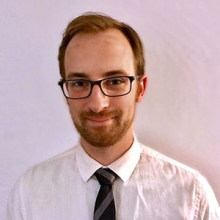-
Title
Deputy Division Leader, Operations -
Email
weisz3@llnl.gov -
Phone
(925) 422-0971 -
Organization
Not Available
Research Interests
David Weisz is a multi-disciplinary research scientist with a background in analytical chemistry, actinide chemistry, plasma chemistry, and chemistry at high temperature/pressure. He has experience in an array of spatially-resolved material characterization techniques. In 2013, he started conducting research at LLNL while acquiring his PhD in nuclear engineering at the University of California, Berkeley. During this time, he studied the composition of glassy fallout from a historical nuclear test using nano-scale secondary ion mass spectrometry, electron probe microanalysis, and scanning electron microscopy to better understand fallout formation chemistry. He started as a post-doctoral researcher at LLNL in the Chemical & Isotopic Signatures group in 2016. In 2017, he received the Dr. Ian Hutcheon Postdoctoral Fellowship sponsored by the Department of Homeland Security, which provides two years of funding to support nuclear forensics research and mentorship.
Weisz is currently interested in research across a broad range of fields including fallout formation, vapor-phase uranium chemistry, laser ablation plasma chemistry, high-temperature spectroscopy, diffusion modeling, and tektite formation.
Ph.D., Nuclear Engineering, University of California, Berkeley, 2016
M.S., Health Physics, Georgetown University, 2012
B.S., Chemistry, Virginia Commonwealth University, 2008
- B. Koroglu, S. Wagnon, Z. Dai, J. Crowhurst, M. R. Armstrong, D. G. Weisz, M. Mehl, J. M. Zaug, H. B. Radousky, and T. P. Rose (2018). Gas phase chemical evolution of uranium, aluminum, and iron oxides. Submitted to Scientific Reports.
- D. G. Weisz, J. C. Crowhurst, M. Finko, T. Rose, B. Koroglu, R. Trappitsch, H. B. Radousky, W. J. Siekhaus, M. R. Armstrong, B. H. Isselhardt, M. Azer, and D. Curreli (2018). The Effects of Plume Hydrodynamics and Oxidation on the Composition of a Condensing Laser-Induced Plasma. Journal of Physical Chemistry A 122, 1584–1591.
- D. G. Weisz, B. Jacobsen, N. E. Marks, K. B. Knight, B. H. Isselhardt, and J. E. Matzel (in press). Diffusive Mass Transport in Agglomerated Glassy Fallout from a Near-Surface Nuclear Test. Geochimica et Cosmochimica Acta.
- M. Finko, D. Curreli, M. Azer, D. Weisz, J. Crowhurst, T. Rose, B. Koroglu, H. Radousky, J. Zaug, and M. Armstrong (2017). A model of early formation of uranium molecular oxides in laser-ablated plasmas. Journal of Applied Physics D 50, 485201.
- B. Koroglu, M. Mehl, M. Armstrong, J. Crowhurst, T. Rose, D. Weisz, H. Radousky, J. Zaug, E. Stavrou, Z. Dai, A. Chernov, E. Ramon, K. Knight, A. Fabris, and M. Cappelli (2017). Plasma Flow Reactor for Steady State Monitoring of Physical and Chemical Processes at High Temperatures. Review of Scientific Instruments 88, 093506.
- D. G. Weisz, J. C. Crowhurst, W. J. Siekhaus, T. P. Rose, B. Koroglu, H. B. Radousky, J. M. Zaug, M. R. Armstrong, B. H. Isselhardt, M. J. Savina, M. Azer, M. Finko, and D. Curreli (2017). Formation of 238U16O and 238U18O by time-resolved emission spectroscopy subsequent to laser ablation. Applied Physics Letters 111, 34101.
- D. Weisz, B. Jacobsen, N. Marks, K. Knight, B. Isselhardt, J. Matzel, S. Prussin, and I. Hutcheon (2017). Deposition of vaporized species onto fallout glass from a near-surface nuclear test. Geochimica et Cosmochimica Acta 201, 410–426.
- DHS/NTNFC’s Dr. Ian Hutcheon Postdoctoral Fellowship, 2017
- Alpha Nu Sigma – Nuclear Engineering Honors Society, 2014
- Student Commencement Speaker for Georgetown Biomedical Graduate School, May 2012
- Georgetown University Graduate Merit Scholarship, 2011
- VCU Presidential Scholarship, 2003-2007


